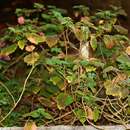en
names in breadcrumbs


Abstract:
Pogostemoncablin is a known aromatic plant which is cultivated for its essential oil widely applicated in perfumery and cosmetic industries. In the present study, the effect of biofield treatment was studied on the growth of P. cablin. For this study an in-vitro culture system was set up in two groups, viz., control and treatment, each of which was derived from three different explant sources, namely leaf, node and petiole. Further these in-vitro plantlets were hardened and transferred to external environment. The stomatal cells and epidermal hair growth were also studied at various morphogenetic stages. The study revealed that a single spell of biofield energy treatment produced significant increase in growth in treated group throughout all the morphogenetic phases from in-vitro to in vivo level. A remarkable increase in stomatal cells and epidermal hair was also seen in treated group.
Patchouli[note 1] (/pəˈtʃuːli/; Pogostemon cablin) is a species of flowering plant in the family Lamiaceae, commonly called the mint or deadnettle family. The plant grows as a bushy perennial herb, with erect stems reaching up to 75 centimetres (2.5 ft) in height and bearing small, pale pink-white flowers.
It is native to the island region of Southeast Asia, including Sri Lanka, Indonesia, the Malay Peninsula, New Guinea and the Philippines. It is also found in many parts of North East India.[1] Noted for its fragrant essential oil, it has many commercial uses and is now extensively cultivated in tropical climates around the world, especially in Asia, Madagascar, South America and the Caribbean. Indonesia currently produces over 90% of the global volume of patchouli oil (~1,600 metric tons).
The word derives from the Tamil patchai (Tamil: பச்சை) or paccuḷi, meaning "green", and ellai (Tamil: இலை), meaning "leaf".[2][3]
Patchouli grows well in warm to tropical climates. It thrives in hot, humid weather but not extended periods of direct sunlight. If the plant withers due to lack of water, it tends to recover quickly after rain or watering. Although rare, the seed-producing flowers are very fragrant and blossom in late autumn. The tiny seeds may be harvested for planting, but they are very delicate and easily crushed. Cuttings and grafts from the mother plant and subsequent rooting in loamy soil are the most common methods for propagation.
Extraction of patchouli's essential oil is by steam distillation of the dried leaves[4] and twigs,[5] requiring rupture of its cell walls by steam scalding, light fermentation, or drying. The main chemical component of patchouli oil is patchoulol, a sesquiterpene alcohol.[6]
Leaves and twigs may be harvested several times a year. Some sources say the highest quality oil is produced from fresh, share dried biomass distilled close to where they are harvested;[7] others say that boiling the dried leaves and fermenting them for a period of time is best.[8]
The heavy, strong, woody, and earthy scent of patchouli has been used for centuries in perfumes, and more recently in incense, insect repellents, chewing tobacco, and many alternative medicines.
Pogostemon cablin, P. heyneanus and P. plectranthoides are all cultivated for their essential oil, known as patchouli oil. Although there are some sub-varieties, the most common commercial varieties are native to the islands of Sumatra and Sulawesi in Indonesia.
Patchouli is used widely in modern perfumery[13] by individuals who create their own scents, [14] as well as in modern scented personal products, such as Bay Rum, and industrial products, too, such as paper towels, laundry detergents, and air fresheners. Two important components of its essential oil are patchoulol and norpatchoulenol.[14]
One study suggests that patchouli oil may serve as an all-purpose insect repellent.[15] More specifically, the patchouli plant has been found to be a potent repellent against the Formosan subterranean termite.[16]
Patchouli is an important ingredient in East Asian incense. Both patchouli oil and incense underwent a surge in popularity in the 1960s and 1970s in the US and Europe, mainly as a result of the hippie movement of those decades.[17]
Patchouli leaves have been used to make a herbal tea. In some cultures, the leaves are eaten as a vegetable or used as a seasoning. There are also several herbal medicines, both in Indonesia and in China (TCM), that include dry, ground patchouli leaves as one of the key ingredients.
In 1985, American toy manufacturer Mattel used patchouli oil in the plastic used to produce the action figure Stinkor in the Masters of the Universe line of toys.[18]
Gene Tierney's character Ellen in the movie Leave Her to Heaven (1945) was given the nickname Patchouli by her husband in the film.
The song "Year of the Cat" (1976) by Al Stewart contains the line, "She comes in incense and patchouli."
Patchouli Knowledge is a recurring character in the bullet-hell game series Touhou Project.
Patchouli (/pəˈtʃuːli/; Pogostemon cablin) is a species of flowering plant in the family Lamiaceae, commonly called the mint or deadnettle family. The plant grows as a bushy perennial herb, with erect stems reaching up to 75 centimetres (2.5 ft) in height and bearing small, pale pink-white flowers.
It is native to the island region of Southeast Asia, including Sri Lanka, Indonesia, the Malay Peninsula, New Guinea and the Philippines. It is also found in many parts of North East India. Noted for its fragrant essential oil, it has many commercial uses and is now extensively cultivated in tropical climates around the world, especially in Asia, Madagascar, South America and the Caribbean. Indonesia currently produces over 90% of the global volume of patchouli oil (~1,600 metric tons).